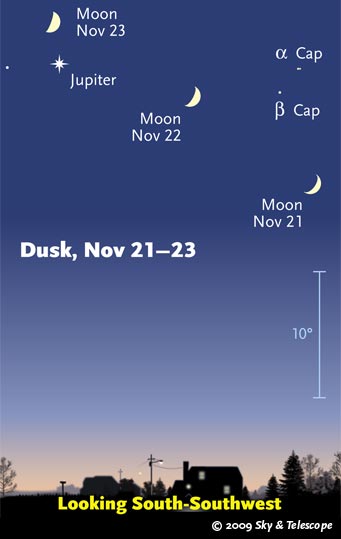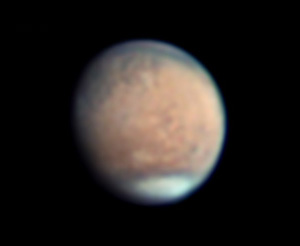Some daily events in the changing sky for November 20 – 28.

Watch the waxing Moon creep up on Jupiter from night to night. (This scene is drawn for the middle of North America. European observers: move each Moon symbol a quarter of the way toward the one for the previous date. The blue 10° scale is about the size of your fist held at arm's length.)
Sky & Telescope diagram
Friday, November 20
Saturday, November 21
Sunday, November 22
Monday, November 23
Tuesday, November 24
Wednesday, November 25
Thursday, November 26
Friday, November 27
Saturday, November 28
Want to become a better amateur astronomer? Learn your way around the constellations. They're the key to locating everything fainter and deeper to hunt with binoculars or a telescope. For an easy-to-use constellation guide covering the whole evening sky, use the big monthly map in the center of each issue of Sky & Telescope, the essential magazine of astronomy. Or download our free Getting Started in Astronomy booklet (which only has bimonthly maps).

The Pocket Sky Atlas plots 30,796 stars to magnitude 7.6 — which may sound like a lot, but that's less than one star in an entire telescopic field of view, on average. By comparison, Sky Atlas 2000.0 plots 81,312 stars to magnitude 8.5, typically one or two stars per telescopic field. Both atlases include many hundreds of deep-sky targets — galaxies, star clusters, and nebulae — to hunt among the stars.
Sky & Telescope
Once you get a telescope, to put it to good use you'll need a detailed, large-scale sky atlas (set of charts; the standards are Sky Atlas 2000.0 or the smaller Pocket Sky Atlas) and good deep-sky guidebooks (such as Sky Atlas 2000.0 Companion by Strong and Sinnott, the more detailed and descriptive Night Sky Observer's Guide by Kepple and Sanner, or the classic Burnham's Celestial Handbook). Read how to use them effectively.
Can a computerized telescope take their place? I don't think so — not for beginners, anyway (and especially not on mounts that are less than top-quality mechanically). As Terence Dickinson and Alan Dyer say in their Backyard Astronomer's Guide, "A full appreciation of the universe cannot come without developing the skills to find things in the sky and understanding how the sky works. This knowledge comes only by spending time under the stars with star maps in hand and a curious mind." Without these, "the sky never becomes a friendly place."
More beginners' tips: "How to Start Right in Astronomy".
This Week's Planet Roundup
Mercury is hiding deep in the sunset.
Venus (magnitude –3.9) is disappearing low in the dawn. Look for it just above the east-southeast horizon about 30 minutes before your local sunrise time.

On November 18th, when Sky & Telescope's Sean Walker took this stacked-video image, Mars had grown to 9.0 arcseconds in diameter. The most obvious features are the North Polar Cap and Cloud Hood at bottom, its dark "collar," and the Solis Lacus complex at top. "Good seeing this morning," writes Walker. "Note the bright cloud in Arcadia [just above the North Polar Cap collar]; the yellowish color is intriguing; could it be a small dust storm?"
S&T: Sean Walker
Mars (magnitude +0.1, in Cancer) rises as early as 10 p.m. now, far below Castor and Pollux in the east. It's very high in the south before dawn. In a telescope Mars is 9 arcseconds wide and growing. Can you make out its north polar cap, bordered by a dark polar-cap collar? Any other surface features? Clouds? See the Mars map and observing guide in the December Sky & Telescope, page 57. Mars is on its way to opposition late next January, when it will be 14.1 arcseconds wide.
Jupiter (magnitude –2.3, in Capricornus) shines brightly in the south in twilight, and lower in the southwest later in the evening. It sets around 10 p.m.
Saturn (magnitude +1.0, in the head of Virgo) shines in the southeast before and during dawn. In a telescope, its rings are still tilted only 4° from edge-on.
Uranus (magnitude 5.8, below the Circlet of Pisces) is highest in the south during early evening.
Neptune (magnitude 7.9, in Capricornus) lurks 4° east of Jupiter. Use our finder charts for Uranus and Neptune.
Pluto is lost in the sunset.
All descriptions that relate to your horizon or zenith — including the words up, down, right, and left — are written for the world's mid-northern latitudes. Descriptions that also depend on longitude (mainly Moon positions) are for North America. Eastern Standard Time (EST) equals Universal Time (also known as UT, UTC, or GMT) minus 5 hours.
To be sure to get the current Sky at a Glance, bookmark this URL:
http://SkyandTelescope.com/observing/ataglance?1=1
If pictures fail to load, refresh the page. If they still fail to load, change the 1 at the end of the URL to any other character and try again.
 0
0
Comments
You must be logged in to post a comment.